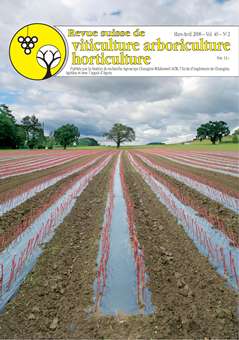
Issue 2 - March - April 2008
Abstract in open access
Since 2005, Ethephon is registered for all apple cultivars in Switzerland. This agent can be applied at three phenological stages: flower «pink», petal fal» or at 8-12 mm fruit diameter (at least 14 days after flowering). The application rate is 0.3- 0.5 l/ha. Thinning effect depends on the temperature, optimal at 18-22 °C. Above 25 °C (risk of overthinning) or below 15 °C, Ethephon should not be applied. When used in combination with NAAm at petal fall, conditions for NAAm should be followed. The impact of Ethephon varies very much. On one hand the thinning effect may fail, on the other hand the risk of overthinning is higher compared to the usual agents NAAm and NAA. With the admission of Ethephon and the setting of three application stages, the thinning of a cultivar can be more adapted to the different growing stages. However, Ethephon application is to be considered especially for cultivars with thinning difficulties or alternate bearing as a supplement to NAAm or NAA. Ethephon is not recommended with Golden Delicious for its low impact and russeting stimulation.
Keywords: apple, fruit thinning, Ethephon
E-Mail: albert.widmer@agroscope.admin.ch
Adress: Agroscope, 8820 Wädenswil
Abstract in open access
In Olivone (900 m), the four sage varieties (Salvia officinalis L.) Regula, 13/6, Valy and Montenegro were tested for their frost hardiness, their agronomic aptitudes and the chemical composition of their essential oils. Valy and Montenegro were very sensitive to frost despite the installed protection against cold. 13/6 was the most tolerant variety, followed by Regula. The latter was the most productive, showing a fine and regular vegetative growth. Overall, 13/6 showed the most regular vegetative growth and Montenegro was characterised by its weak growth. For all four varieties tested, the content of essential oils and the amount of the principal molecules thujone and camphor was modest. Compared to the other varieties, Montenegro had the lowest content of camphor and borneol.
Keywords: production, vegetative growth, chemical composition, essential oil.
E-Mail:
Adress: Agora
Abstract in open access
The eriophyoid mite Phyllocoptes gracilis (Nalepa) is an important secondary pest species in Swiss raspberry production. The pending withdrawal of the only registered miticide bromopropylate has created the need to develop alternative control strategies against this mite. In autumn 2006, first efficacy trials were carried out in a heavily infested plot of the variety Glen Ample in Nendaz (Switzerland). Single, post harvest applications of wettable sulphur and of the miticide spirodiclofen were both very effective and provided excellent pest control. Visual inspection in the following spring confirmed the value of these control strategies. The costs of post harvest treatments with wettable sulphur are lower than bromopropylate applications and the timing of application does not pose any risk of pesticide residues. Before products tested can be considered for registration against P. gracilis, the optimal timing of control, long-term efficacy and phytotoxicity still have to be determined.
Keywords: Phyllocoptes gracilis, raspberries, post harvest treatments, sulphur, spirodiclofen.
E-Mail: catherine.baroffio@agroscope.admin.ch
Adress: Agroscope, 1260 Changins/Nyon
Abstract in open access
In Switzerland, the climate of Ticino is best suited for the cultivation of rosemary (Rosmarinus officinalis L.). This study aimed to identify and to characterise clones adapted to the conditions of Ticino. Forty-three clones were collected from mother plants older than 15 years and from an altitude between 250 and 1010 m. Each clone was cultivated at two sites (Gudo, 280 m, and Olivone, 900 m). Agronomic aptitudes, contents of essential oils and their chemical composition were analysed. The agronomic aptitude of rosemary clones showed a high genetic variability. The two sites’ mean content of essential oils was 1.98% and 2.3%, respectively. Chemical analysis distinguished four groups: 1) a group of camphene, 2) of 1,8-cineole and _-pinene, 3) of bornyl acetate and limonene, 4) of _-pinene and verbenone. None of the clones resisted winter at Olivone.
Keywords: rosemary, essential oils, chemical composition, yield, agronomical performance.
E-Mail:
Adress: Agora
Abstract in open access
Agrotextiles fabrics are occasionally used in mountain areas during growing period to cover the cultures of aromatic plants, mainly for increasing dry matter yield. From 2004 to 2006, tests with and without cover were carried out in producers fields on peppermint, bergamot mint and melissa to study the impact of this process on quality and dry matter yield. Yield as well as essential oil content were generally improved by the microclimate generated under the fabric, especially in spring and at the beginning of summer. However the effects strongly varied from one species to another. Bergamot mint, as thermophilic species, especially gained in dry matter yield, whereas melissa and peppermint essential oil contents sensibly increased. The composition of peppermint essential oil was qualitatively more influenced by the cover than this of the two other species.
Keywords: agrotextile, peppermint, bergamote, melissa, dry matter, essential oil.
E-Mail: claude-alain.carron@agroscope.admin.ch
Adress: Agora
Abstract in open access
Seasoning of cooperage oak wood is mainly aimed at decreasing relative humidity of fresh wood between 14 and 18%, in order to optimize the mechanical, oenological and organoleptic properties of staves. When staves are seasoned in open air, they may require up to 2-3 years to reach such humidity levels and to modify their initial chemical composition, depending on stave thickness and on climatic conditions (temperature, air humidity, rain, wind, etc.). A too short seasoning period usually degrades the aromatic properties of wood and thus of wine. Immature staves contain aromatic and polyphenolic compounds, some of which being responsible for bitter and drying tastes of casked wines. In order to optimize barrel construction and toasting, the influence of seasoning time on wine quality was examinated in a cooperage of central Switzerland.
Keywords: climatic conditions, oak staves, seasoning time, wine quality.
E-Mail:
Adress:

 Download of full issue
Download of full issue
 Download article
Download article